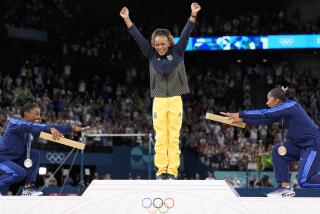He Has at Least One Doctor’s Seal of Approval
- Share via
You’re watching Barry Bonds jog four bases for the 700th time, blindsiding Babe, hammering Hank, greatness jogging toward history, but you can’t help it.
You’re not cheering. You’re not feeling chills. You don’t believe the moment. You don’t believe the man.
You think Bonds is juiced. You think his home runs are tainted. You think his records are wrong. You secretly wish he would twist his giant neck and fall on his oversized jaw and ...
Stop it.
You’re wrong.
If you’re going to base your steroid cynicism on science, you should listen to a leading steroid scientist, and Dr. Robert Goldman agrees that you’re wrong.
“It’s very unfair, what is happening to Bonds,” Goldman said. “A home run is still a home run.”
Goldman is the Chicago-based chairman of the International Medical Commission, which oversees sports medicine committees in nearly 200 nations. Goldman has disqualified many athletes for positive steroid tests and preached against the drug’s use.
But he says to understand steroids’ benefits to a baseball hitter, one must first acknowledge the drug’s limitations.
Steroids cannot swing a bat. Steroids cannot pick out a pitch. Steroids cannot connect on a 95-mph fastball. Steroids cannot propel a ball 400 feet.
“To say Barry Bonds hits those home runs because of steroids is a bit overdone,” Goldman said. “He hits them because he possesses a rare skill set. He hits them because of biomechanics.”
Barry Bonds, in other words, keeps his eye on the ball.
So why can’t the rest of us?
Why can’t America see past the unproven accusations and appreciate the greatest power hitter in baseball history, a man who one day will break the greatest record -- 755 homers -- in sports history?
Babe Ruth was a better player because he also pitched. Willie Mays was a better player because he was a better fielder.
But Bonds, who should rank third overall, is a better power hitter than both, without asterisk and without question.
Yet that won’t stop folks on TV and radio today from angrily screaming about the size of his head, the sculpting of his neck, the steroid-soiling of his work.
This indignant foot-stomping will make ‘roid rage look like bad mood.
“Media people today are looking for the quick kill, the big story, not caring whose career they damage,” Goldman said. “Nothing has been proven. What is happening with Bonds is unfairly taking away from the moment.”
It is a moment that was not fueled by drugs, but by work.
A quick fix? Before the 2001 season, when Bonds’ body changed and he started breaking records, he was already averaging 34 homers a season.
A sudden impact? More than a decade ago, he hit 46 home runs in one season.
He was hitting home runs when he was a skinny punk in Pittsburgh. He was hitting home runs as a new guy in San Francisco.
Except for his breakout year in 2001 -- hey, Roger Maris had that same sort of freak year, remember? -- Bonds has been a consistently churning home run assembly line.
He might have the best hand-eye coordination in baseball history, one of the most efficient batting strokes in history, and think how many homers he would have if pitchers hadn’t been walking him more than anyone in history?
“He is among the first era of athletes who have worked harder as they have gotten older, and he deserves credit for that,” Goldman said. “He is hitting balls that would be out of the park even without the added strength that steroids might give him.”
So how much added strength would that be?
Goldman guessed that a ball hit from a steroid-bulged athlete, under ideal conditions, if the athlete stayed in the weight room long enough, might travel 20 feet farther.
“But that’s only if you can first hit the ball, and hit it far enough to make a difference, “ Goldman said. “There are lots of powerful guys who can’t hit the ball like Bonds.”
Take Ken Caminiti and Jose Canseco, both admitted steroid users, both physical freaks.
Caminiti averaged 17 homers a season and never hit more than 40. Canseco averaged 27 homers a season, and eventually Bonds could end up hitting 300 more homers than he did.
If steroids can so easily send you around the bases, how come Bonds stands so alone?
Critics reply that something is wrong because Bonds is hitting so many more homers than anyone else. Well, when Ruth was the first player to hit 700 homers, nobody else had half that many.
It was spectacular in San Francisco on Friday night, Bonds hitting the pitch from San Diego’s Jake Peavy into the left-field stands, rounding the bases alone, the simple triumph of a man, a bat and a ball.
To inject steroids into the picture would be just wrong.
*
Bill Plaschke can be reached at bill.plaschke@latimes.com. To read previous columns by Plaschke, go to latimes.com/plaschke.
More to Read
Go beyond the scoreboard
Get the latest on L.A.'s teams in the daily Sports Report newsletter.
You may occasionally receive promotional content from the Los Angeles Times.











